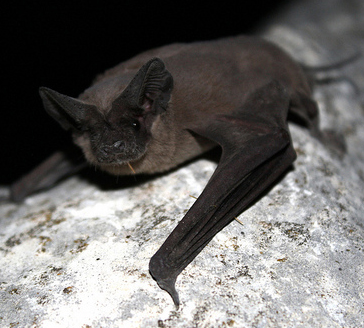As the sun set and an evening breeze cooled the air, 24 workshop participants gathered around the picnic shelter at Chadron State Park in western Nebraska, faces full of anticipation of what the evening would bring. Todd Filipi, biologist with Pheasants Forever, left with bags and gloves in hand to go check mist nets strung across a pond and along a creek, hoping to catch not birds, but bats. Participants had come from as far away as Omaha and as nearby as Chadron to attend this two-day workshop and learn more about this diverse and ecologically important suite of mammals.

A Mexican free-tailed bat is one of 16 bat species found in Nebraska, according to Bat Conservation International (photo by USFWS/Ann Froschauer).
Hosted jointly by the U.S. Fish and Wildlife Service, Nebraska Game and Parks Commission, Pheasants Forever and Rocky Mountain Bird Observatory, the WILD About Bats workshop held earlier this summer introduced participants to the world of bats. They learned about native and worldwide species of bats, talked about common misconceptions of bats and, most importantly, discussed why we need bats and what current threats are facing them.
The workshop kicked off with a “Bat IQ Test,” then moved into the basics of bats, followed by creating PSAs to dispel common misconceptions about bats (such as bats getting caught in peoples’ hair), before wrapping up the evening with an attempt to catch bats in mist nets and a talk about native bats.

Workshop participants enjoyed a good laugh during the echolocation activity. Photo by Amanda Filipi.
The next morning began with a roundtable discussion of the environmental benefits of bats. Did you know that one of our native bat species, the little brown bat, can catch and eat 1,000 mosquitoes an hour? Neither did many of us before the workshop. Next, we headed outdoors to learn about echolocation. Most participants formed a circle, with a few who were bats or moths inside the circle. The bats, with eyes closed, moved around calling “bat” and listening for the bounce-back of “moth” or “tree,” either from the moving moths or the stationary tree circle. Though it was difficult for the trees to keep from laughing while they watched the bats and moths dance about in the circle, this activity gave everyone a clearer picture of how bats use echolocation to draw their mental image of the world.
The workshop concluded with what we can do, as citizens and educators, to help bats here in Nebraska and around the world. Perhaps not surprisingly, many of the same actions that benefit bats also help birds: provide ample water sources in backyards, plant a wide variety of flowers to attract nectar feeders and limit the use of pesticides and insecticides so there are plenty of insects.
Alas, attempts to catch bats in mist nets didn’t result in any bats in the hand. We did see them flying around after insects as twilight fell, but they evaded capture – just one more firsthand lesson in how wildlife research is never a sure thing when it comes to catching live animals.
Workshop presenters were Jeanine Lackey with the U.S. Fish and Wildlife Service, Amanda Filipi with Nebraska Game and Parks Commission, Todd Filipi with Pheasants Forever and Maggie Vinson with Rocky Mountain Bird Observatory, with additional funding support from the Nebraska Environmental Trust Fund.
~ Maggie Vinson, Nebraska Education Coordinator


